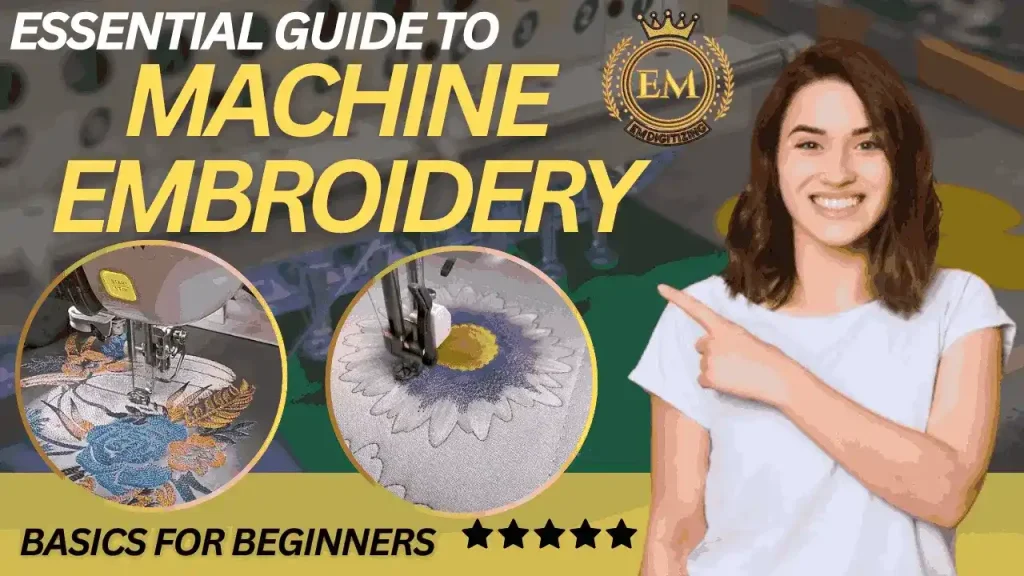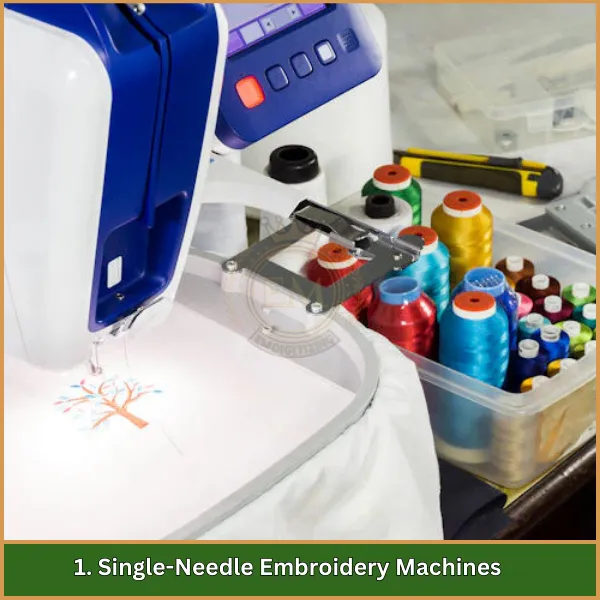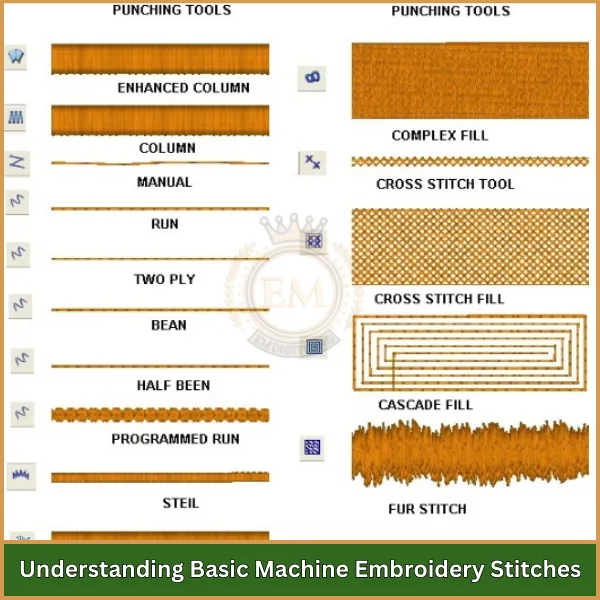Se sei nuovo al ricamo, comprendere le nozioni di base del ricamo a macchina può sembrare un po’ travolgente. Ma non preoccuparti: siamo qui per analizzarlo passo dopo passo! In questa guida, ti guideremo attraverso tutto ciò che devi sapere per iniziare, dalla scelta della macchina e dei materiali giusti all'apprendimento dei punti e delle tecniche di base.
Il ricamo a macchina apre infinite possibilità creative, permettendoti di personalizzare l'abbigliamento, regali, e decorazioni per la casa con i tuoi disegni. Imparando queste basi, sarai in grado di trasformare tessuti semplici in bellissimi, pezzi personalizzati. Così, tuffiamoci ed esploriamo gli elementi essenziali, aiutandoti a sviluppare la sicurezza e le competenze necessarie per creare splendidi progetti di ricamo.

Guida essenziale alle nozioni di base del ricamo a macchina per principianti
Materiali di base necessari per il ricamo a macchina
Comprendere le basi del ricamo a macchina, è essenziale conoscere i materiali e gli strumenti di base, compreso il software, che rendono il processo fluido e di successo. Ecco gli elementi chiave di cui avrai bisogno:
- Macchina da ricamo
- Cerchi da ricamo
- Fili da ricamo
- Software per ricamo
- Stabilizzatori
- Aghi da ricamo
- Tessuto
- Forbici
Ora che comprendi gli elementi essenziali delle basi del ricamo, approfondiamo ogni componente in dettaglio.
1. Macchina da ricamo
Una macchina da ricamo è un dispositivo specializzato progettato per cucire motivi e disegni complessi sul tessuto. A differenza delle macchine da cucire standard, le macchine da ricamo utilizzano file digitali e cuciture automatizzate per produrre risultati precisi, risultati coerenti. Sono essenziali sia per gli hobbisti che per i professionisti che desiderano apprendere le basi del ricamo a macchina e creare disegni personalizzati o personalizzati.
Tipi di macchine da ricamo
È disponibile in vari tipi, ciascuno progettato per soddisfare esigenze diverse, dai semplici progetti domestici all'uso commerciale ad alto volume. Ecco uno sguardo approfondito ai principali tipi di macchine da ricamo:
1. Macchine da ricamo ad ago singolo

Le macchine da ricamo ad ago singolo sono il tipo più comune per uso domestico. Hanno un ago, which means the machine can only handle one color of thread at a time. To create multi-colored designs, you need to change the thread manually for each color.
Caratteristiche:
- Facilità d'uso: Single-needle machines are user-friendly and straightforward, making them ideal for beginners.
- Dimensioni compatte: These machines are usually smaller and more portable, perfect for home setups.
- Versatilità: Some single-needle models can also function as sewing machines, adding value for users interested in both sewing and embroidery.
Meglio per: Hobbisti, beginners, and those who do embroidery projects occasionally.
2. Macchine da ricamo multi-needle

Macchine da ricamo multiago are designed for efficiency and are often used by professionals. These machines have multiple needles (typically 4 a 10), allowing them to hold multiple thread colors simultaneously and switch automatically during stitching.
Caratteristiche:
- Velocità ed efficienza: Multi-needle machines save time by automatically changing colors, rendendoli molto più veloci per progetti complessi.
- Dimensioni del campo di ricamo più elevate: Molte macchine multiago offrono campi di ricamo più ampi, ideale per progetti più grandi o più dettagliati.
- Funzionalità avanzate: Spesso sono dotati di funzioni avanzate come il taglio automatico del filo, rilevamento della rottura del filo, e impostazioni di cucitura personalizzabili.
Meglio per: Professionisti, proprietari di piccole imprese, o chiunque gestisca progetti di ricamo complessi o ad alto volume.
Caratteristiche principali da considerare quando si sceglie una macchina da ricamo
Quando si seleziona una macchina da ricamo di base per principianti, alcune caratteristiche chiave possono fare una grande differenza nella tua esperienza di ricamo. Ecco le cose principali da cercare:
- Disegni e caratteri incorporati: Molte macchine sono dotate di design e caratteri precaricati, rendendo più semplice avviare subito i progetti.
- Dimensioni del campo di ricamo: Questa è l'area massima che puoi ricamare in una singola intelaiatura. Campi più grandi consentono progetti più grandi.
- Velocità di cucitura: Velocità di cucitura più elevate fanno risparmiare tempo, soprattutto per progetti di grandi dimensioni o disegni dettagliati.
- Opzioni di trasferimento del design: Controlla se la macchina supporta USB, Wifi, o connessioni dirette al computer per trasferire facilmente i progetti.
- Taglio automatico del filo: Questa funzione taglia il filo tra i punti, mantenendo il lavoro ordinato e risparmiando tempo.
- Touch screen a colori: Un touch screen a colori può aiutarti a visualizzare in anteprima e modificare i disegni con facilità prima della cucitura.
Ognuna di queste funzionalità può migliorare la tua esperienza di ricamo, quindi è utile scegliere in base alle esigenze e alle preferenze del progetto.
2. Cerchi da ricamo

Sono strumenti essenziali nel ricamo a macchina, utilizzato per tenere il tessuto saldamente in posizione mentre la macchina cuce i disegni. Garantiscono stabilità, ridurre lo spostamento, e aiuta a mantenere la precisione di ogni punto, che è fondamentale per risultati puliti e professionali. Ecco uno sguardo approfondito ai telai da ricamo e alla loro importanza.
Tipi di telai da ricamo
- Cerchi standard: Questi sono i telai base forniti con la maggior parte delle macchine da ricamo. Sono generalmente utilizzati per progetti più piccoli o progetti semplici e sono perfetti per i principianti.
- Cerchi magnetici: I cerchi magnetici utilizzano magneti per tenere il tessuto in posizione. Sono ideali per tessuti delicati che potrebbero danneggiarsi con i tradizionali telai di fissaggio, come la seta o il cotone sottile.
- Cerchi Jumbo o multiposizione: Questi telai sono più grandi e consentono di cucire disegni più grandi o composti da più parti senza reintelaiarli. Sono particolarmente utili per progetti di grandi dimensioni come le coperte, giacche, o trapunte.
- Cerchi regolabili: Alcuni cerchi consentono regolazioni delle dimensioni, che li rende versatili per vari progetti di ricamo. Sono utili quando si passa da un design di dimensioni diverse all'altro.
3. Fili da ricamo

Sono un componente chiave nel ricamo a macchina, dare vita ai disegni con colori vivaci, trame, e finiture. La qualità e il tipo di filo scelto possono influenzare notevolmente l'aspetto, durabilità, e il successo complessivo del tuo progetto di ricamo. Esploriamo nel dettaglio i fili da ricamo per comprenderne il ruolo, tipi, e consigli per il loro utilizzo.
Tipi di fili da ricamo
Comprendere i diversi tipi di fili da ricamo è essenziale per padroneggiare le basi del ricamo a macchina. Ciascun tipo offre qualità uniche che possono influire sull'aspetto e sulla durata dei tuoi progetti.
- Filo di rayon: Noto per i suoi colori vivaci e la sua lucentezza, ideale per disegni decorativi con finitura liscia.
- Filo di poliestere: Durevole e resistente allo sbiadimento, perfetto per capi che verranno lavati frequentemente, come uniformi e abbigliamento sportivo.
- Filo di cotone: Ha una finitura opaca, fornendo un aspetto naturale, ed è eccellente per design vintage o più morbidi.
- Filo metallico: Aggiunge brillantezza e consistenza, ideale per progetti decorativi, richiede però un'attenta manipolazione a causa della sua natura delicata.
- Filo di seta: Lussuoso e liscio, utilizzato per progetti di ricamo delicati o di fascia alta; aggiunge una multa, finitura elegante.
- Filo variegato: Cambia colore lungo il filo, creando un effetto sfumato unico che aggiunge interesse ai disegni semplici.
Ogni tipo di filo ha usi specifici, allowing you to choose based on your project’;s esigenze e l'effetto desiderato.
Pesi e spessore del filo
I fili da ricamo sono disponibili in diversi pesi, di solito vanno da 30 a 60. I numeri più bassi indicano fili più spessi, mentre i numeri più alti rappresentano fili più fini. La scelta del peso corretto è importante:
- 40-filo di peso è il più comune e funziona bene per il ricamo generale.
- 60-filo di peso è più fine e adatto per disegni dettagliati o scritte piccole.
- 30-filo di peso è più spesso, ideale per design audaci che devono distinguersi.
4. Software per ricamo

È uno strumento vitale per creare, la modifica, e convertire i disegni in ricamo a macchina. Consente agli utenti di personalizzare i modelli, regolare i tipi di punto, e persino convertire le immagini in formati adatti al ricamo. Con il software giusto, sia i principianti che i professionisti possono facilmente dare vita alle loro idee creative sul tessuto.
Scopo del software di ricamo
Il software di ricamo svolge molteplici funzioni, dalla creazione del design di base alla modifica avanzata. Consente agli utenti di:
- Crea disegni originali: Disegna o importa forme e motivi da creare disegni di ricamo unici.
- Modifica modelli esistenti: Modifica i progetti esistenti ridimensionandoli, rotante, o cambiare i colori per soddisfare i requisiti del progetto.
- Converti file: Trasforma file di immagine standard (come JPEG o PNG) nei formati di file di ricamo (Come DST, PES, o exp) che le macchine possono leggere.
- Disegni di anteprima: Guarda come apparirà il disegno una volta cucito, consentendo regolazioni prima di iniziare il processo di ricamo.
Caratteristiche principali da cercare nel software di ricamo
- Interfaccia user-friendly: Un'interfaccia semplice è utile, soprattutto per i principianti, in quanto rende l'apprendimento del software più semplice e veloce.
- Opzioni di personalizzazione del progetto: Cerca funzionalità come l'aggiunta di testo, ridimensionamento, regolazioni del colore, e stratificazione per personalizzare ogni disegno.
- Compatibilità dei file: Assicurati che il software supporti i formati di file letti dalla tua macchina da ricamo, Come DST, PES, o Jef.
- Anteprima e simulazione: Consente di visualizzare in anteprima l'aspetto del disegno sul tessuto, aiutando a identificare eventuali problemi prima della cucitura.
- Modifica dei punti: Alcuni software consentono la modifica avanzata dei tipi di punto, densità, e direzione, che è utile per progetti più complessi.
5. Stabilizzatori

Sono materiali essenziali utilizzati nel ricamo a macchina per fornire supporto e impedire che il tessuto si allunghi o si deformi durante la cucitura. Aiutano a mantenere la forma del tessuto, prevenire le grinze, e assicurarsi che i punti rimangano puliti e ben definiti. La scelta dello stabilizzatore giusto è fondamentale per ottenere risultati di ricamo di alta qualità, soprattutto su tessuti difficili.
Tipi di stabilizzatori
- Stabilizzatori tagliati: Forniscono un supporto permanente e rimangono attaccati al tessuto dopo la cucitura. Sono ideali per tessuti elastici o delicati che necessitano di stabilità duratura.
- Stabilizzatori a strappo: Progettato per il supporto temporaneo, si strappano facilmente dopo la cucitura. Ideale per tessuti stabili come cotone e denim che non richiedono un supporto a lungo termine.
- Stabilizzatori solubili in acqua: Si dissolve completamente in acqua, senza lasciare traccia dietro. Perfetto per disegni in pizzo o tessuti trasparenti dove non vuoi alcuno stabilizzatore visibile.
Stabilizzatori anti-calore: Rimosso applicando calore, rendendoli ideali per tessuti che non possono essere lavati o strappati. Questi stabilizzatori funzionano bene con materiali delicati o speciali.
6. Aghi da ricamo

Sono appositamente progettati con occhi più grandi e una superficie liscia, punta arrotondata per gestire i fili da ricamo senza causare sfilacciature o intoppi. Scegliere la dimensione e il tipo di ago corretti è essenziale per ottenere un risultato pulito, punti uniformi su vari tipi di tessuto.
7. Tessuto

È la base per qualsiasi progetto di ricamo, e scegliere quello giusto può influenzare notevolmente il risultato finale. Tessuti diversi interagiscono in modo univoco con fili e stabilizzatori, quindi selezionare il tipo di tessuto appropriato è importante per una finitura liscia e professionale.
8. Forbici

Sono strumenti essenziali per tagliare i fili, stabilizzatori di taglio, e rifinire con precisione i progetti di ricamo. Avere il giusto paio di forbici rende il processo di ricamo più fluido e aiuta a ottenere un risultato pulito, finitura professionale.
Comprendere i disegni da ricamo a macchina

Sono modelli digitali che guidano la macchina da ricamo nella creazione di immagini dettagliate, loghi, e testo su tessuto. Tuttavia, avere semplicemente un design non è sufficiente; per raggiungere la professionalità, risultati raffinati, i progetti devono essere sottoposti a un passaggio cruciale chiamato digitalizzazione.
Questo processo converte il disegno in un formato leggibile dalla macchina con istruzioni precise su come deve essere realizzato ogni punto. If you’;Stai solo imparando le nozioni di base del ricamo a macchina, consigliamo vivamente di assumere un professionista per la digitalizzazione, poiché richiede esperienza per regolare i tipi di punto, densità, e indicazioni basate sulle complessità del tessuto e del design.
Per risultati di ricamo impeccabili, si consiglia vivamente di assumere un digitalizzatore professionista. EMdigitizing offre eccezionali dservizi di digitalizzazione per trasformare i tuoi disegni in file da ricamo di alta qualità. Il nostro team di esperti di EMdigitizing utilizza le tecniche più recenti per garantire che ogni disegno sia perfettamente adatto al tuo tessuto e alla tua macchina, offrendo un'esperienza di ricamo senza interruzioni.
Scegliendo EMDigitalizzazione, stai investendo in precisione e qualità che distinguono davvero i tuoi progetti di ricamo. Gestiamo noi le complessità della digitalizzazione così potrai concentrarti sulla creazione di qualcosa di bello, ricamo dettagliato che dura. Ordina ora per una finitura professionale di cui ti puoi fidare!
Formati di file per i disegni da ricamo
Vengono salvati in formati di file specifici che le macchine da ricamo possono leggere e interpretare. Ogni marca di macchina può richiedere un formato diverso, quindi è importante sapere quale tipo di file è adatto alla tua attrezzatura.
- Ora legale: Un formato ampiamente utilizzato, soprattutto per macchine da ricamo commerciali.
- PES: Comunemente utilizzato con macchine da ricamo Brother e Baby Lock.
- JEF: Utilizzato dalle macchine Janome e compatibile con varie macchine da ricamo domestiche.
- SCAD: Compatibile con le macchine Bernina e altre macchine di livello professionale.
La scelta del formato file corretto è essenziale per ottenere i migliori risultati con la tua macchina. Garantisce che i dettagli e le specifiche del punto del tuo disegno vengano trasferiti accuratamente, ottenendo un prodotto finale lucido.
Comprensione dei punti di ricamo a macchina di base

Quando impari le basi del ricamo a macchina, comprendere i diversi tipi di punti è essenziale per creare disegni di alta qualità. Ogni tipo di punto aggiunge una trama unica, dimensione, e dettagli ai tuoi progetti di ricamo. Ecco uno sguardo ai punti più comuni utilizzati nel ricamo a macchina:
- Punto raso: Conosciuto per la sua morbidezza, finitura lucida, il punto pieno è comunemente usato per scritte e contorni. Crea un denso, linea audace ed è ideale per aggiungere enfasi ad alcune aree di un design.
- Punto di riempimento (Punto Tatami): Questo punto copre ampie aree con un riempimento uniforme e viene spesso utilizzato per sfondi o forme solide. Il motivo a punto previene le arricciature e dona un equilibrio, aspetto strutturato.
- Punto corrente: Un semplice, punto a linea singola utilizzato per delineare, dettagli, o creare linee sottili in un disegno. È veloce ed economico, rendendolo adatto per i dettagli leggeri.
- Punto di fagioli (Punto triplo): Un punto continuo rinforzato che ripassa ciascuna linea tre volte, creando un aspetto più audace, linea più duratura. I punti a fagiolo sono eccellenti per i contorni e per aggiungere definizione.
- Punto a zigzag: Questo punto si alterna in uno schema a zigzag, aggiungendo consistenza e una qualità leggermente elastica. È utile per fissare i bordi o aggiungere un dettaglio accattivante.
- Punto catenella: Imitando un aspetto cucito a mano, il punto catenella viene spesso utilizzato nei ricami decorativi. Crea una struttura, effetto in loop, aggiungendo profondità e carattere al design.
- Punto croce: Utilizzato per creare una griglia o un motivo strutturato, il punto croce è spesso visto nei disegni più tradizionali e aggiunge un tocco unico, fascino d'altri tempi.
- Nodo francese: Un punto speciale che crea piccoli, nodi in rilievo per aggiungere dettagli e texture a parti specifiche del disegno, come centri floreali o accenti.
Padroneggiando questi punti base del ricamo a macchina, puoi creare cose bellissime, design versatili con una gamma di texture ed effetti, dando vita ai tuoi progetti con stile e precisione.
Conclusione
Insomma, padroneggiare le nozioni di base del ricamo a macchina ti metterà sulla strada per creare creazioni meravigliose, pezzi personalizzati con fiducia. Che tu stia appena iniziando o perfezionando le tue capacità, avere progettazioni ben preparate è fondamentale per ottenere risultati impeccabili.
Per servizi di digitalizzazione di alta qualità, fidatevi di EMdigitizing! Offriamo le tariffe più convenienti, tempi di consegna super rapidi, e una garanzia di qualità su ogni progetto. Più, con la nostra opzione di anteprima, puoi vedere esattamente come apparirà il tuo disegno prima di cucirlo.
E se è la prima volta con noi, riceverai un'esclusiva 50% spento. Ordina ora e lascia che EMdigitizing dia vita alle tue idee creative con precisione ed eccellenza!
